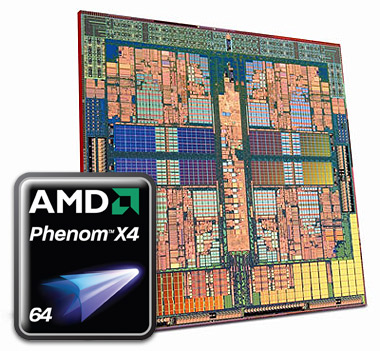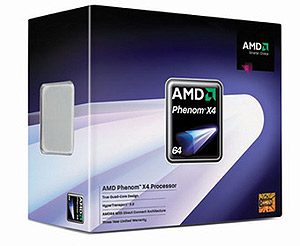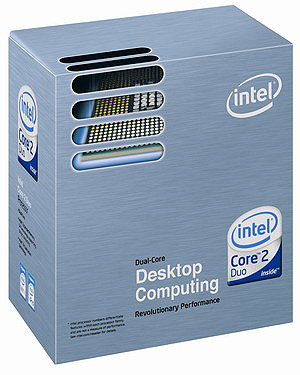The truth of the matter is that gaming is 90% videocard limited,
and whether you pick an Intel or AMD processor is not as relevant as it used to be.
It's not irrelevant, but the days
of AMD being the "gamer's CPU" are as dead as 3DFX.
Round two: AMD vs. Intel - the Gamers Secret
Weapon is...
Where you allot your budget in a gaming PC build
determines the kind of visual and FPS performance you get from it. Too fast a
CPU and too slow a videocard can be as bad as too fast a videocard and too slow
a CPU. The sweet right now is a dual core chip with lots of cache. A good clock speed is always nice, but more cache at an equivalent clock speed
is always best. Both AMD and Intel offer dual and quad core processors,
but despite what the marketing departments are saying, I still firmly believe that quad core chips are a waste
for gaming right now. Don't get me started on triple cores…
 While you might jump at an Intel Core 2 Quad Extreme Edition
CPU, gamers contemplating the AMD vs Intel question should focus on the Intel Core 2 Duo E8500 or
AMD Phenom X4 9950. Each CPU will run you about $250, and a good multi-videocard
compatible motherboard another $200.
While you might jump at an Intel Core 2 Quad Extreme Edition
CPU, gamers contemplating the AMD vs Intel question should focus on the Intel Core 2 Duo E8500 or
AMD Phenom X4 9950. Each CPU will run you about $250, and a good multi-videocard
compatible motherboard another $200.
Quite obviously, serious gamers should avoid systems with integrated graphics or
a motherboard that promotes some kind of hybrid graphics between discreet and
integrated graphics. Videocards exist as stand alone cards for a reason.
Instead, look for a board with dual PCI Express x16 slots that both operate with
a full 16 PCI express lanes each, not x16 and x8, or x8 and x8 mode.
And which CPU is better? For gamers, my money's on the Intel Core 2 Duo E8500 ($250 CDN) right now.
This 3.16 GHz processor is based on the Intel 'Wolfdale' core, which is built on
the 45nm process so it consumes less electricity and generates less heat that
previous 90nm or 65nm chips. The Core 2 Duo E8500 has a large 6MB cache
and runs at a native 1333MHz Front Side Bus (FSB). The E8500 is one step below
Intel's fastest Wolfdale core, the 3.3GHz Core 2 Duo E8600 ($350 CDN). There's
no real difference between the two, aside from a 150MHz clock speed bump and a
$100 CDN bump in cost. Save the $100 and put it towards a better videocard.
But what about quad-core
processors?
Why not pick a quad-core Intel Core 2 Extreme QX9770
processor that represents the flagship of Socket 775 chips and costs a mere
$1800 CDN? Well, aside from the ridiculous price the QX9770 isn't all that much
faster in games than an E8500 would be in an identical system (expect for a few very
specific games which are optimized for quad-cores).
Most 3D games don't take full advantage of quad-core
processors, and overall frames per second are influenced by the capabilities of
the graphics card, instead of the CPU. Don't spend extra money on getting a
processor that gives marginal performance increases in games. An E8000-series
Intel Core 2 Duo chip in this case is the right tool for the job.
 Historically, AMD CPUs have been
THE processors to have if you are a serious gamer. While that used
to be correct for very clear architecture reasons, the edge AMD once held in the gaming arena
is dulled from five years of battle with Intel. AMD's Phenom chips generally can't
compare with the Intel Core 2 Duo/Quad because of lower clock speeds
per core.
Historically, AMD CPUs have been
THE processors to have if you are a serious gamer. While that used
to be correct for very clear architecture reasons, the edge AMD once held in the gaming arena
is dulled from five years of battle with Intel. AMD's Phenom chips generally can't
compare with the Intel Core 2 Duo/Quad because of lower clock speeds
per core.
AMD's fastest chip, the Phenom X4 9950 ($250 CDN), comes second when compared
in equivalent systems packing a Core 2 Duo E8500 in dual-core friendly games.
The handicap is even more pronounced against the Intel Core 2 Quad Q6600 ($240)
in the few games which are quad-core optimized Unreal Tournament 3, Supreme
Commander: Forged Alliance, Lost Planet 2, etc.
As with mainstream PCs, chipsets differentiate the performance motherboard
segment just as much. Intel has released the 4-series chipsets to much acclaim,
while AMD countered with its 790FX. The former is available in hundreds of
configurations, the latter exists in a much smaller volume of boards.
 Okay, so I've told you that the Intel Core 2 Duo E8500 is my current best bet for a
gaming CPU. Pairing that processor with the Asus Striker II Extreme (nvidia
nForce 790i Ultra SLI Chipset) is freaking overkill. The board costs nearly $450
and will give you more features than you know what to do with. ASUS' Striker II
Extreme overclocking features are massive, and if you overclock you'll find
yourself in 7th heaven… but it's wasted on the majority of gaming
enthusiasts.
Okay, so I've told you that the Intel Core 2 Duo E8500 is my current best bet for a
gaming CPU. Pairing that processor with the Asus Striker II Extreme (nvidia
nForce 790i Ultra SLI Chipset) is freaking overkill. The board costs nearly $450
and will give you more features than you know what to do with. ASUS' Striker II
Extreme overclocking features are massive, and if you overclock you'll find
yourself in 7th heaven… but it's wasted on the majority of gaming
enthusiasts.
The gaming essentials are Crossfire or SLI
multi-videocard support, four memory slots, hardware RAID 0, basic overclocking and sufficient passive chipset cooling.
To be frank, pretty much any multi-videocard supporting motherboard will get you in
the door here. However, when it comes to dual videocard gaming with
the aforementioned options its hard to beat the Intel X48 chipset,
or nvidia's 790i chipset.
Both chipsets give support for multiple video cards using either Crossfire
X or SLI technology (your choice), and motherboards using either technology
will cost around $250.
If you plan on running a single PCI Express videocard like the dual GPU AMD
Radeon HD 4870 X2 or nVidia Geforce 280GTX, here's a tip.
All you need is board based on the Intel P45, nVidia 750i, or any chipset
from the same price range. Boards built for multi-videocard gaming are not inherently faster than those
best suited for single videocards. A P45 or even P35 board
is technically as fast an X48.
Likewise, an nVidia nForce 750i is just as quick as a 780i/790i . The
platforms only diverge in gaming prowess when additional videocards are dropped
in and SLI'd or Crossfire'd up.
Stick to one videocard with that Intel Core 2 Duo E8500, save another
$150 on the motherboard and get the same gaming performance as with a board
that costs twice as much. PCSTATS will cover the pros and cons of SLI and Crossfire
systems another day.
Round three
is next, so if you want to know what the ultimate high end system is built
with... follow along!
